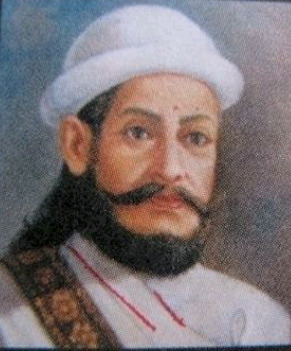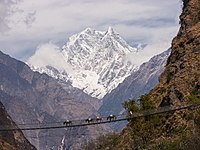Portal:Nepal
|
Mount Everest,Koshi,Nepal  Budhanilkantha Temple in Budhanilkantha, Nepal
  Nepal, officially the Federal Democratic Republic of Nepal, is a landlocked country in South Asia. It is mainly situated in the Himalayas, but also includes parts of the Indo-Gangetic Plain. It borders the Tibet Autonomous Region of China to the north, and India to the south, east, and west, while it is narrowly separated from Bangladesh by the Siliguri Corridor, and from Bhutan by the Indian state of Sikkim. Nepal has a diverse geography, including fertile plains, subalpine forested hills, and eight of the world's ten tallest mountains, including Mount Everest, the highest point on Earth. Kathmandu is the nation's capital and the largest city. Nepal is a multi-ethnic, multi-lingual, multi-religious and multi-cultural state, with Nepali as the official language. The name "Nepal" is first recorded in texts from the Vedic period of the Indian subcontinent, the era in ancient Nepal when Hinduism was founded, the predominant religion of the country. In the middle of the first millennium BC, Gautama Buddha, the founder of Buddhism, was born in Lumbini in southern Nepal. Parts of northern Nepal were intertwined with the culture of Tibet. The centrally located Kathmandu Valley is intertwined with the culture of Indo-Aryans, and was the seat of the prosperous Newar confederacy known as Nepal Mandala. The Himalayan branch of the ancient Silk Road was dominated by the valley's traders. The cosmopolitan region developed distinct traditional art and architecture. By the 18th century, the Gorkha Kingdom achieved the unification of Nepal. The Shah dynasty established the Kingdom of Nepal and later formed an alliance with the British Empire, under its Rana dynasty of premiers. The country was never colonised but served as a buffer state between Imperial China and British India. Parliamentary democracy was introduced in 1951 but was twice suspended by Nepalese monarchs, in 1960 and 2005. The Nepalese Civil War in the 1990s and early 2000s resulted in the establishment of a secular republic in 2008, ending the world's last Hindu monarchy. The Constitution of Nepal, adopted in 2015, affirms the country as a secular federal parliamentary republic divided into seven provinces. Nepal was admitted to the United Nations in 1955, and friendship treaties were signed with India in 1950 and China in 1960. Nepal hosts the permanent secretariat of the South Asian Association for Regional Cooperation (SAARC), of which it is a founding member. Nepal is also a member of the Non-Aligned Movement and the Bay of Bengal Initiative. (Full article...)
 The Fifth Deuba cabinet was the Government of Nepal from 13 July 2021 to 26 December 2022. It was formed after Sher Bahadur Deuba was appointed as the new prime minister of Nepal by president Bidya Devi Bhandari following an order from the Supreme Court, which declared the dissolution of the House of Representatives on the recommendation of former prime minister KP Sharma Oli to be unlawful. The fifth Deuba cabinet was replaced by the Dahal cabinet, 2022 on 26 December 2022, when Pushpa Kamal Dahal's CPN (Maoist Centre) broke away from the electoral alliance with Nepali Congress and joined hands with other opposition parties to form a government in the aftermath of the 2022 general election. The cabinet consisted of an alliance of political parties formed in opposition of former prime minister Oli's dissolution of the House of Representatives. It consisted of Nepali Congress, the CPN (Maoist Centre), CPN (Unified Socialist) and People's Socialist Party, Nepal during formation. The Loktantrik Samajbadi Party, Nepal and Rastriya Janamorcha provides confidence and support to the government. (Full article...) This is a Good article, an article that meets a core set of high editorial standards.
Matrikas (Sanskrit: मातृका (singular), IAST: mātṝkā, lit. "mothers") also called Matar or Matri, are a group of mother goddesses who are always depicted together in Hinduism. The Matrikas are often depicted in a group of seven, the Saptamatrika(s) (Seven Mothers). However, they are also depicted as a group of eight, the Ashtamatrika(s). In the Brihat Samhita, Varahamihira says that "Mothers are to be made with cognizance of (different major Hindu) gods corresponding to their names." They are associated with these gods as their spouses or their energies (Shaktis). Brahmani emerged from Brahma, Vaishnavi from Vishnu, Maheshvari from Shiva, Indrani from Indra, Kaumari from Kartikeya, Varahi from Varaha and Chamunda from Chandi. and additionals are Narasimhi from Narasimha and Vinayaki from Ganesha. Originally believed to be a personification of the seven stars of the star cluster the Pleiades, they became quite popular by the seventh century and a standard feature of goddess temples from the ninth century onwards. In South India, Saptamatrika worship is prevalent whereas the Ashtamatrika are venerated in Nepal, among other places. (Full article...)
 Mount Everest, the highest peak on earth, lies on the Nepal-China border
Amar Singh Thapa distinguished as Badakaji Amar Singh Thapa(Nepali: बडाकाजी अमर सिंह थापा), or Amar Singh Thapa The Elder, (also spelled Ambar Simha) also known by the honorific name Bada Kaji ("Senior Kaji") or Budha Kaji ("The Old Kaji"), was a Gorkhali military general, governor and warlord in the Kingdom of Nepal. He was the overall commander of the Nepal Army in the conquest of Western Provinces and authoritative ruler of Kumaon, Garhwal in the Kingdom of Nepal. He was referred by the King of Nepal to have been deployed as Mukhtiyar (equivalent to Prime Minister) of Western Provinces of Kumaon, Garhwal. He is often hailed as Living Tiger of Nepal (Nepali: ज्यूँदो बाघ; jyūm̐do bāgha) and was posthumously regarded as one of the national heroes of Nepal, who led the Anglo-Nepalese War for the Gorkhali Army. Amarsingh Chowk Pokhara and Shree Amarsingh Model Higher Secondary School are named after Amar Singh Thapa. (Full article...) Chunlā (Newar: चुंला, "ground meat") is a traditional meat dish of the Kathmandu Valley in Nepal. It is meat finely chopped by a chopping knife or meat grinder. Chunlā is a popular dish in Newar cuisine and is similar to Qeema found in other parts of South Asia. (Full article...)
The following pages at Wikimedia Commons contain a plethora of images taken in Nepal.
Wiki Loves Earth is an international photographic competition to promote natural heritage sites around the World through Wikimedia projects (mainly Wikipedia and Wikimedia Commons).
 Wiki Loves Monuments is an international photographic competition to promote cultural monuments around the World through Wikimedia projects (mainly Wikipedia and Wikimedia Commons.
The following are images from various Nepal-related articles on Wikipedia. Indian Subcontinent Other countries The following Wikimedia Foundation sister projects provide more on this subject:
Discover Wikipedia using portals |

































































